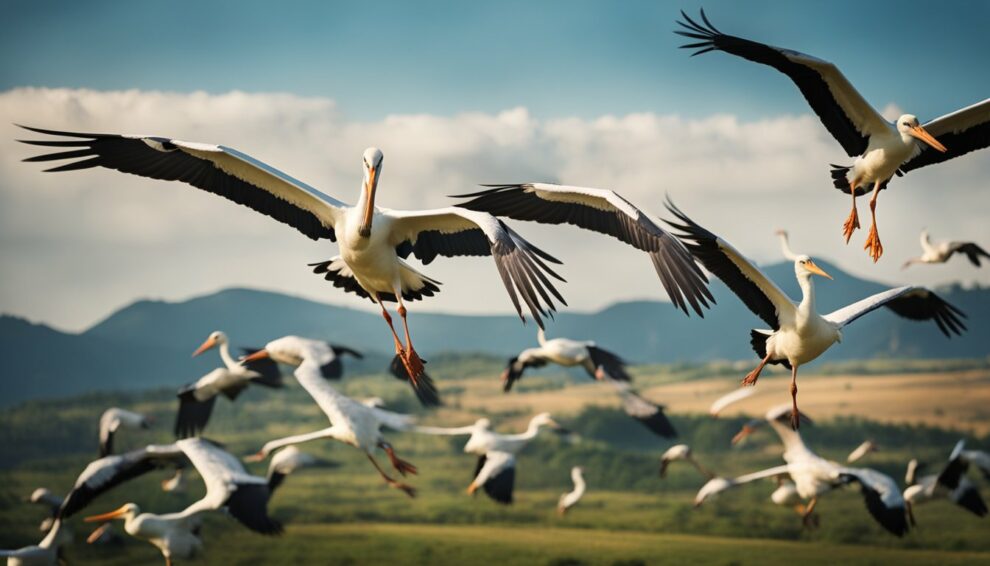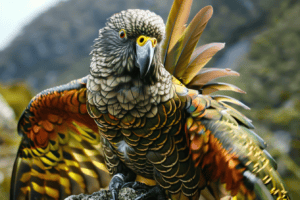Storks are long-legged, long-necked birds with a penchant for travel.
Come springtime, these avian adventurers set off on an impressive journey, spanning continents and oceans, from the warm savannas of Africa to the bustling towns of Europe and Asia.

Imagine being able to fly thousands of miles each year, relying only on your wings and the invisible highways traced by nature’s hand in the sky.
This is the reality for storks, whose annual migration is a natural marvel that has intrigued humans for generations.
During their migratory trek, they become part of the landscape, with sightings of their large, elegant silhouettes often signifying the changing seasons.
Have you ever watched a flock of birds and wondered where they’re headed?
Well, those storks soaring high above are embarking on a trip that could easily span over 10,000 kilometers.
They navigate using the sun, stars, and even the earth’s magnetic field.
This might sound like something out of a superhero comic, but for storks, it’s just a part of life.
What’s truly special about storks is not just their ability to cover large distances but also their role in human culture.
They’re revered in many societies, with folklore connecting them to themes of luck, birth, and renewal.
The iconic image of a stork carrying a bundle represents the arrival of a newborn, a story passed down through generations that adds to the endearing image of these birds.
So, the next time you spot a stork, think of the incredible journey that bird has made or is about to make, as it connects continents and people through its epic flight.
Stunning Storks: Pillars of the Sky
Storks stand tall and regal, silently surveying the land from their lofty nests.
These birds connect continents through their remarkable migratory journeys, blending the lore of old with the ecological significance of today.
Highlighting the White Stork
The white stork, a prominent member of the storks’ family, is easily recognized by its striking plumage and elegant stature.
Standing over a meter tall with wings spanning up to 217 cm, it truly seems like the pillars of the sky.
White storks migrate from Europe to Africa, adjusting their habitat with the seasons.
Consistent with their adaptability, they flourish in various environments, from wetlands to grasslands.
They are a symbol of good fortune in folklore, and seeing one is believed to herald positive change.
A Global Phenomenon: Stork Species Across Continents
Storks are not just limited to one region; they are a global phenomenon, with different species finding their homes across multiple continents.
Each species has adapted to its environment, showcasing the incredible versatility of these birds.
For instance, in Europe, the white stork makes its presence known boldly; whereas, in Africa, some species have become indigenous parts of the landscape.
These migrations aren’t just for show – they reveal the birds’ integral role in various ecosystems as they travel.
The Architectural Marvels of Nesting Sites
Have you ever wondered why storks build such enormous nests? Well, nesting sites are more than just homes; they’re masterpieces of bird architecture.
Storks return to the same structures year after year, continuously adding materials.
Interestingly, it’s not just about providing a place to lay eggs – these nests serve as social hubs and are even known to protect houses from fires in folklore.
As humans, we can learn a lot about sustainable building from these feathered engineers.
The Great Journey: Unveiling Migration Secrets

Every year, storks embark on an epic migration that spans continents and challenges their survival.
This journey is not just a simple flight; it’s a remarkable demonstration of endurance and adaptation.
Mapping the Migration: Routes Connecting Continents
Storks have mapped out a superhighway in the sky, connecting their breeding grounds in Europe to their winter quarters in Africa.
They traverse thousands of miles, with some routes snaking from Germany and Austria to the warm landscapes of the Sahara.
It’s like a long-distance race where the Mediterranean Sea acts as a giant hurdle.
As they approach, they concentrate their numbers and funnel through the natural passageway of Gibraltar, the gateway between the two continents.
Navigating Nature’s Challenges During Flight
Imagine you’re flying high above the ground, with nothing but your own strength to carry you across vast areas like the Sahara.
Sounds tough, doesn’t it?
That’s exactly what storks face during their energetically expensive migration.
They don’t just brave the treacherous desert; they also rely on thermals—columns of rising air—to help lift them with minimal energy over the sea and other obstacles.
This strategy is a clever way to conserve their strength for the long journey.
Incredible Adaptations for Survival
Storks are equipped with remarkable adaptations that make their challenging journey possible.
They have long wings perfect for soaring on thermals, and their exceptional eyesight helps them spot those invisible thermal columns that are so crucial for an efficient flight.
They’ve even learned to use wind patterns to their advantage.
Did you know that older storks use their experience from past journeys to choose more direct routes?
This efficiency is not seen in the younger birds, who tend to wander more.
As a result, the European stork population represents a spectrum of seasoned veterans and eager novices all sharing the skyways in pursuit of warmer climates.
Life Cycle of the Stork: Birth to Migration

The life cycle of storks is a remarkable journey from hatchling to seasoned traveler.
In their early days, these birds undergo rapid growth, and by the time they reach adulthood, they’re ready to participate in rituals of courtship and ensure the success of their species through breeding.
From Egg to Sky: The Early Days
Storks begin their lives as eggs laid in a carefully crafted nest, usually high up to keep away from predators.
These nests can be quite the sight, sometimes built atop telephone poles or rooftops!
Within these nests, the eggs incubate for about a month before the hatchlings break through their shells.
These nests are often reused and refurbished each year by the same stork pair.
Initially, the stork chicks are entirely dependent on their parents for food and protection.
Parents take turns bringing back a variety of tasty meals, from insects to small mammals, ensuring their young have all they need to grow strong.
Have you ever seen a baby stork’s first attempt at flight? It’s a bit clumsy but an important step in their journey to adulthood.
By the time they are 2 months old, they are usually ready to take off and explore the skies.
The Circle of Life: Courtship, Breeding, and Growth
When storks reach maturity, the circle of life continues.
Each spring, they perform elaborate courtship rituals. Did you know white storks clatter their bills as part of their courtship?
This is their way of saying hello and strengthening their pair bond.
It’s quite a spectacle paired with their elaborate dances and sky-high circling.
Finding a mate and securing a nest are crucial for their reproductive success.
Once a pair is formed, they lay between 2 to 5 eggs, and both parents share the job of incubating them.
It’s a lot of work, but teamwork makes the dream work in the stork world!
Life tracking data helps scientists understand their breeding patterns, including when they lay eggs and how many young they raise each season.
Threats to the Majestic Migrators & Conservation Efforts

The white stork, with its impressive wingspan and elegant flight, faces hurdles that threaten its survival.
Conservation efforts are crucial to ensure these avian adventurers grace our skies for generations to come.
Human Impacts: Collisions and Habitat Loss
Collisions with vehicles and electrocution from power lines are significant dangers for the stork population, often occurring during their long migratory journeys.
These travelers of the sky also grapple with habitat loss, as wetlands and grasslands are converted into agricultural or urban areas.
It’s hard to imagine these large birds being vulnerable, but their nesting sites and feeding grounds are disappearing at an alarming rate, putting their very existence at risk.
Conservation Champions: Global Initiatives to Protect Storks
Recognizing the importance of the migratory routes of these elegant beings, conservation groups have stepped forward as champions for their protection.
Several initiatives aim to secure vital stopover sites that are not currently protected.
Imagine there’s a global safety net, a patchwork quilt of habitats across countries, tailor-made to shelter and nurture storks along their voyage.
That’s the aspiration of these conservationists, who tirelessly work to mitigate threats and protect the future of migratory birds.
Frequently Asked Questions

Storks have long captivated our imaginations with their migratory habits and cultural significance.
These questions delve into the specifics of their journeys and cultural impact, providing vivid insights into the lives of these remarkable birds.
What places do storks call home during their stay in Europe?
During their time in Europe, storks can be seen adorning the skies and landscapes from Spain to Scandinavia.
They often choose to nest atop old buildings, chimneys, and specially made platforms, creating iconic silhouettes against the European countryside.
Wetlands, grasslands, and agricultural fields serve as their favored feeding grounds where they forage for food.
Can you describe the journey white storks embark on when they migrate?
White storks undertake an annual migration that is a true test of endurance.
They traverse thousands of miles, harnessing thermal currents to glide over vast lands and waters.
These journeys span continents, with storks often crossing the Strait of Gibraltar or following the eastern Mediterranean route to avoid the perilous Sahara.
To which destinations do storks travel when they leave their nesting sites?
When the air turns crisp signaling the end of summer, storks bid farewell to their European territories and set off for warmer climes.
Their destinations include the savannas of Sub-Saharan Africa and the warm marshes of India, where the climate is more forgiving, and food is plentiful, ensuring their survival through the winter months.
How have the storks become a symbol of cultural significance in Alsace?
In Alsace, storks are more than just birds; they’re woven into the cultural tapestry, symbolizing good luck and fidelity.
Their presence is celebrated, with stork motifs popping up on buildings and local art.
The inhabitants regard these birds with affection and have taken active steps to protect and encourage their return each year.
What is the story behind the multitude of stork nests found in France?
Imagine quaint villages dotted with rooftops crowned by stork nests—this scene is not uncommon in parts of France.
The stork’s affinity for building nests atop structures has led to a harmonious coexistence with humans.
Local communities often embrace their feathered friends by erecting platforms to support and encourage nesting.
What are the reasons behind storks’ annual long-distance flights to Africa?
Africa beckons storks with its promise of warmth and abundant food, critical for survival when Europe cools.
These journeys are driven by instinct and the need to find suitable habitats to feed and breed.
The flight to Africa represents an instinctive rhythm set by generations of storks navigating between continents in a perpetual cycle of movement and change.









